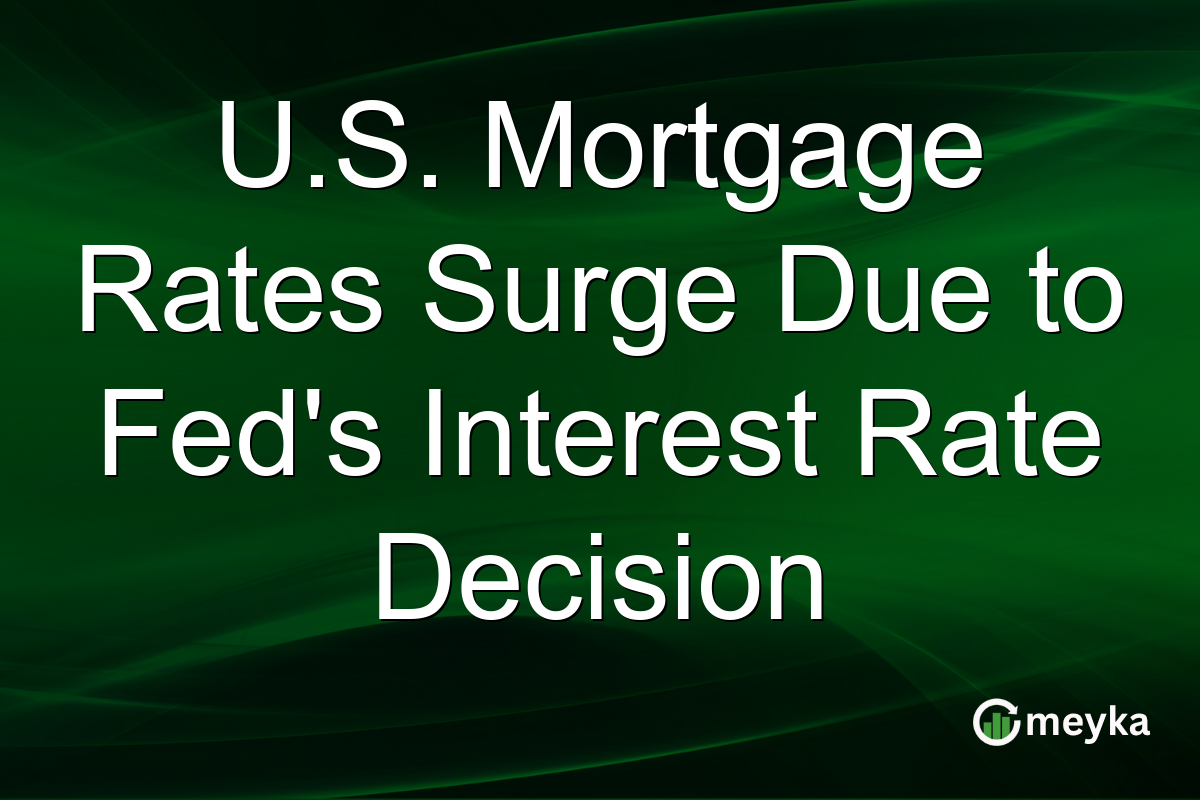U.S. Mortgage Rates Surge Due to Fed’s Interest Rate Decision
In a significant market shift, U.S. mortgage rates have surged to new 2025 highs, following the Federal Reserve’s recent signal of maintaining high interest rates longer than previously expected. This surge has pushed 30-year mortgage rates above 7.5%, creating a wave of concern for potential homebuyers and intensifying affordability issues. Let’s delve into how this development impacts the housing market and what it means for future homebuyers.
Understanding the Surge in Mortgage Rates
The Federal Reserve’s decision to maintain its tightened monetary policy has sent current mortgage rates soaring. Recently, 30-year mortgage rates breached the 7.5% mark, the highest since the beginning of the year. This increase is a direct response to the Fed’s commitment to battling inflation, even at the cost of slowing down economic activity. Investors have been closely watching these movements, as they significantly influence borrowing costs across the country. With the central bank hinting at keeping rates elevated, the mortgage market has reacted accordingly. According to CNBC, the expectation of prolonged high interest rates is keeping rates elevated, consequently impacting homebuyers’ purchasing power. This scenario has led many to reevaluate their home-buying plans. The rate increase translates to much higher monthly payments, making it challenging for many potential buyers to afford new homes. Analysts predict this may dampen the recovery of the housing market, which is already experiencing a slowdown.
Impact on Home Affordability
The spike in 30-year mortgage rates is reshaping the landscape of home affordability. When we look at how this affects buyers, the numbers tell a stark story. A sudden jump from a 3% interest rate to over 7.5% increases monthly payments by hundreds of dollars. For instance, on a $400,000 loan, payments could rise by more than $800 per month. As reported by Reuters, this shift has ushered in a phase where first-time homebuyers, in particular, are feeling the pinch. Many are priced out of the market as they struggle to keep up with the rising costs, compounded by stagnant wages and persistent inflation. This could lead to a notable decrease in home purchases, creating a domino effect that could potentially slow economic growth further. However, some may choose to delay buying, hoping for potential rate relief in the future. Yet, economists caution that waiting might not guarantee lower rates, especially with the current economic indicators.
Housing Market Slowdown Concerns
The current mortgage rates have not only affected individual buyers but have also cast a shadow over the broader housing market. With higher borrowing costs, fewer people are listing homes, expecting to sell quickly. This trend contributes to concerns about a prolonged housing market slowdown. Bloomberg highlights that as these rates tick upward, builders are also facing challenges. Construction of new homes is slowing down, with companies cautious about overextending their portfolios in uncertain times. This slowdown is exacerbated by high labor and material costs. Such conditions create a tricky environment for real estate investors, who are now reevaluating their strategies. While this might mean a deceleration in market activity, some suggest it could stabilize home prices, which have been soaring over the past few years. Buyers who are still in the game may find fewer competitors, possibly leading to more advantageous negotiations.
Future Outlook and Strategies for Homebuyers
Looking ahead, potential homebuyers must develop strategic approaches to navigate this challenging period. Understanding the market trends and current mortgage rates is crucial. While some experts hope for a minor rate relief in late 2025, reliance solely on this is risky. Mortgage financial advisors recommend buyers lock in rates now if they find an acceptable deal. According to industry insights, adjustable-rate mortgages might also gain popularity. These loans can offer lower initial rates, providing temporary alleviation from high fixed rates. Utilizing resources such as Meyka’s financial tools can aid in making informed decisions. Meyka offers real-time analytics, helping investors and homebuyers track market shifts effectively. This approach ensures that even in a heightened rate environment, buyers can still make economically sound decisions.
Final Thoughts
The recent surge in U.S. mortgage rates underscores the need for prospective homebuyers to remain vigilant and informed. With the Fed’s stance on interest rates shaping market conditions, affordability remains a critical issue. While challenges persist, strategic planning and utilizing analytical resources like Meyka can guide buyers through these turbulent times. Staying informed and adaptable will be key in navigating the home buying journey in this evolving mortgage landscape.
FAQs
Mortgage rates are rising due to the Federal Reserve’s decision to keep interest rates high to combat inflation, leading to increased borrowing costs.
A 7.5% rate significantly increases monthly mortgage payments, making homes less affordable, especially for first-time buyers, due to higher overall costs.
Homebuyers can consider locking in current rates, exploring adjustable-rate mortgages, and using financial tools to assess market conditions effectively.
Disclaimer:
This is for information only, not financial advice. Always do your research.






